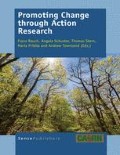Abstract
Classrooms are, for the most part, safe places, generally free from scrutiny, where teachers are free to live stories of practice. These lived stories are essentially secret ones. Furthermore, when these secret lived stories are told, they are, for the most part, told to other teachers in other secret places. When teachers move out of their classrooms into the out-of-classroom place on the landscape, they often live and tell cover stories, stories in which they portray themselves as experts, certain characters whose teacher stories fit within the acceptable range of the story of school being lived in the school.
Access this chapter
Tax calculation will be finalised at checkout
Purchases are for personal use only
Preview
Unable to display preview. Download preview PDF.
References
Attard, K. (2012). The role of narrative writing in improving professional practice. Educational Action Research, 20(1), 161–175.
Autio, T. (2003). Postmodern paradoxes in Finland: The confinements of rationality in curriculum studies. In W. Pinar (Ed.), International handbook of curriculum research (pp. 301–328). New Jersey, London: Lawrence Erlbaum Associates Publishers.
Ayers, W., Quinn, T., Stovall, D. O., & Scheiern, L. (2008). Teachers’ experience of curriculum: Policy, pedagogy and situation. In F. M. Connelly, M. F. He, & J. Phillion (Eds.), The Sage handbook of curriculum and instruction (pp. 306–326). Thousand Oaks, CA: Sage Publications.
Behar-Horenstein, L. S. (1999). Narrative research: Understanding teaching and teacher thinking. In A. C. Ornstein, & L. A. Behar-Horenstein (Eds.), Contemporary issues in curriculum (pp. 90–102). Boston, MA: Lllyn and Bacon.
Brunner, D. P. (1994). Inquiry and reflection: Framing narrative practice in education. New York, NY: State University of New York Press.
Dick, B. (2001). Action research: Action and research. In S. Sankaran, B. Dick, R. Passfield, & P. Swepson (Eds.), Effective change management using action learning and action research (pp. 21–27). Lismore: Southern Cross University Press.
Carr, W., & Kemmis, S. (1986). Becoming critical. Education, knowledge and action research. London: The Falmer Press.
Clandinin, J., & Connelly, M. (1986). Classroom practice: Teacher images in action. London: Falmer.
Clandinin, J., & Connelly, M. (1990). Narrative experience and the study of curriculum. Cambridge Journal of Education, 20(3), 241–254.
Clandinin, J., & Connelly, M. (1996). Teachers’ professional knowledge landscapes: Teachers’ stories – stories of teachers – School stories – Stories of schools. Educational Researcher, 25(3), 24–30.
Clandinin, J., & Connelly, M. (2000). Narrative inquiry: Experience and story in qualitative research. San Francisco, CA: Jossey-Bass.
Clandinin, J., & Connelly, M. (2004). Knowledge, narrative and self-study. In J. Loughran, M. Hamilton, V. LaBoskey, & T. Russel (Eds.), International handbook of self-study of teaching and teacher education practices (pp. 575–600). Boston: Kluwer Academic.
Colombo, M. (2003). Reflexivity and narratives in action research: A discursive approach [34 paragraphs]. Forum Qualitative Sozialforschung/Forum: Qualitative Social Research, 4(2), Art. 9, 1–14. Retrieved January 02, 2012 from http://nbn-resolving.de/urn:nbn:de:0114-fqs030291
Connelly, M., & Clandinin, J. (1988). Teachers as curriculum planners: Narratives of experience. New York, NY: Teachers College Press.
Connelly, M., & Clandinin, J. (1990). Stories of experience and narrative inquiry. Educational Researcher, 19(5), 2–14.
Foucault, M. (1988). What is enlightenment? (St. Rozani, Trans.). Athens: Erasmos. (Original work published 1984) [Text in Greek].
Elliott, J. (2005). Using narrative in social research. Qualitative and quantitative approaches. London: Sage.
Ellis, C., & Bochner, A. P. (2000). Autoethnography, personal narrative, reflexivity. In N. Denzin, & Y. Lincoln (Eds), Handbook of qualitative research (pp. 733–768). London: Sage.
Frydaki, E. (2011). Fostering humanity through interpretive dialogue in teachers’ communities. In W. Veugelers (Ed.), Education and humanism. Linking autonomy and humanity (pp. 163–179). Rotterdam: Sense Publishers.
Heikkinen, H. (2002). Telling stories in teacher education. A narrative-biographical view on portfolio work. In: Huttunen, R, Heikkinen, H. & Syrjälä, L. (Eds), Narrative research. Voices of teachers and philosophers (pp. 123–142). Jyväskylä: Sophi.
Heikkinen, H. L. T., Huttunen, R., & Syrjälä, L. (2007). Action research as narrative: Five principles for validation. Educational Action Research, 15(1), 5–19.
Heikkinen, H. L. T., Huttunen, R., & Syrjälä, L. (2012). Action research as narrative: Five principles for validation revisited. Educational Action Research, 20(1), 5–21.
Langley, D. (2012). Women reaching women: a story of change. The role of narrative in building trust and commitment during an action research project. Educational Action Research, 20(1), 41–53.
Johnson, K. E., & Colombeck, P. R. (2002). Teachers narrative inquiry as professional development. Cambridge: Cambridge University Press.
Richardson, V. (2003). Preservice teachers’ beliefs. In J. Rath, & A. C. McAninch (Eds.), Advances in Teacher Education series, 6 (pp. 1–22). Greenwich, CT: Information Age Publishing.
Slattery, P., Krasny, K. A., & O’Malley, M. P. (2007). Hermeneutics, aesthetics, and the quest for answerability: A dialogic possibility for reconceptualizing the interpretive process in curriculum studies. Journal of Curriculum Studies, 39(5), 537–558.
Somekh, B. (2006). Action research: A methodology for teaching and development. Maidenhead, UK: Open University Press.
Webster, L., & Mertova, P. (2007). Using narrative inquiry as a research method. An introduction to using critical event narrative analysis in research on learning and teaching. London and New York: Routledge.
Editor information
Editors and Affiliations
Rights and permissions
Copyright information
© 2014 Sense Publishers
About this chapter
Cite this chapter
Tsafos, V. (2014). The Reflective Perspective of Narrative in Educational Action Research. In: Rauch, F., Schuster, A., Stern, T., Pribila, M., Townsend, A. (eds) Promoting Change through Action Research. SensePublishers, Rotterdam. https://doi.org/10.1007/978-94-6209-803-9_12
Download citation
DOI: https://doi.org/10.1007/978-94-6209-803-9_12
Publisher Name: SensePublishers, Rotterdam
Online ISBN: 978-94-6209-803-9
eBook Packages: Humanities, Social Sciences and LawEducation (R0)

